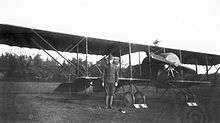Caudron G.3
| Caudron G.3 | |
|---|---|
 | |
| French Caudron G.3 | |
| Role | Reconnaissance aircraft |
| Manufacturer | Caudron |
| First flight | Late 1913[1] |
| Introduction | 1914[1] |
| Primary users | Aéronautique Militaire US Army Air Service Finnish Air Force Polish Air Force |
| Developed from | Caudron G.2 |
The Caudron G.3 was a single-engined French biplane built by Caudron, widely used in World War I as a reconnaissance aircraft and trainer.
Development
The Caudron G.3 was designed by René and Gaston Caudron as a development of their earlier Caudron G.2 for military use. It first flew in May 1914 at their Le Crotoy aerodrome.[2]
The aircraft had a short crew nacelle, with a single engine in the nose of the nacelle, and an open tailboom truss. It was of sesquiplane layout, and used wing warping for lateral control, although this was replaced by conventional ailerons fitted on the upper wing in late production aircraft. Usually, the G.3 was not armed, although sometimes light machine guns and small bombs were fitted.
It was ordered in large quantities following the outbreak of the First World War with the Caudron factories building 1423 of the 2450 built in France. 233 were also built in England and 166 built in Italy along with several other countries. The Caudron brothers did not charge a licensing fee for the design, as an act of patriotism.[2]
It was followed in production by the Caudron G.4, which was a twin-engined development.
Operational history



The G.3 equipped Escadrille C.11 of the French Aéronautique Militaire at the outbreak of war, and was well-suited for reconnaissance use, proving stable and having good visibility. As the war progressed, its low performance and lack of armament made it too vulnerable for front line service, and it was withdrawn from front line operations in mid-1916.[2]
The Italians also used the G.3 for reconnaissance on a wide scale until 1917, as did the British RFC (continuing operations until October 1917), who fitted some with light bombs and machine guns for ground attack.[2] The Australian Flying Corps operated the G.3 during the Mesopotamian campaign of 1915–16.
It continued in use as a trainer until well after the end of the war. Chinese Fengtian clique warlord Caudron G.3s remained in service as trainers until the Mukden Incident of 1931, when many were captured by the Japanese.
In 1921 Adrienne Bolland, a French test pilot working for Caudron, made the first crossing of the Andes by a woman, flying between Argentina and Chile in a G.3.
Variants
Most G.3s were the A.2 model, used by various airforces for artillery spotting on the Western front, in Russia and in the Middle East. The G.3 D.2 was a two-seat trainer, equipped with dual controls and the E.2 was a basic trainer. The R.1 version (rouleur or roller) was used by France and the United States Air Service for taxi training, with the wing trimmed down to prevent its becoming airborne. The last version, the G.3. L2, was equipped with a more powerful 100 hp Anzani 10 radial engine. In Germany, Gotha built a few copies of the G.3 as the LD.3 and LD.4 (Land Doppeldecker - "Land Biplane").
Survivors
Caudron G.3s are displayed in several museums, including at the RAF Museum Hendon, the Musée de l'Air et de l'Espace, Paris, the Royal Army and Military History Museum, Brussels and the Aerospace Museum (Musal), Rio de Janeiro. One aircraft is being restored at the Hallinportti Aviation Museum in Finland.
Operators

- Mesopotamian Half Flight
- Central Flying School AFC at Point Cook, Victoria.
 China
China Colombia
Colombia- Colombian Air Force - Three aircraft became Colombia's first military aircraft.
 Denmark
Denmark- Royal Danish Air Force
 El Salvador
El Salvador- Air Force of El Salvador - Three aircraft.
 Finland
Finland- Finnish Air Force - 12 from France in 1920, six built in Finland by Santahaminan ilmailutelakka from 1921 to 1923. One from Flyg Aktiebolaget in 1923. Withdrawn 1924. Nicknamed Tutankhamon.

 France
France- operated by 38 escadrilles.[1]
.svg.png) Greece
Greece- Hellenic Air Force
 Guatemala
Guatemala
.svg.png) Japan
Japan Peru
Peru- One aircraft only.
 Portugal
Portugal- Portuguese Air Force
 Poland
Poland- Polish Air Force
 Romania
Romania- Royal Romanian Air Force
 Russia
Russia- Imperial Russian Air Force
.svg.png) Serbia
Serbia.svg.png) Kingdom of Spain
Kingdom of Spain- eighteen bought in 1919 for training at Getafe, Seville and Los Alcázares, replaced by Avro 504Ks in 1924.
 Soviet Union
Soviet Union- Soviet Air Force - ex-Imperial Russian Air Force.
 Turkey
Turkey- Turkish Air Force - Postwar.
 United Kingdom
United Kingdom

- Royal Flying Corps
- Royal Naval Air Service - operated 140 primarily as trainers[3]
Specifications (G.3)

Data from Suomen ilmavoimien lentokoneet
General characteristics
- Crew: 1
- Length: 6.40 m (21 ft 0 in)
- Wingspan: 13.40 m (44 ft 0 in)
- Height: 2.50 m (8 ft 3 in)
- Wing area: 27.00 m² (290 ft²)
- Empty weight: 420 kg (933 lb)
- Max. takeoff weight: 710 kg (1,577 lb)
- Powerplant: 1 × Le Rhône 9C rotary, 60 kW (80 hp)
Performance
- Maximum speed: 106 km/h (57 kn, 68 mph)
- Service ceiling: 4,300 m [2] (14,110 ft)
Armament
One light machine gun (optional) and hand released bombs (optional)
See also
- Related development
References
- 1 2 3 Holmes, 2005. p 26.
- 1 2 3 4 5 Donald 1997, p.233.
- ↑ Thetford, Owen (1994). British Naval Aircraft Since 1912. London: Putnam. p. 415. ISBN 0-85177-861-5.
- Donald, David (Editor) (1997). The Encyclopedia of World Aircraft. Aerospace Publishing. ISBN 1-85605-375-X.
- Holmes, Tony (2005). Jane's Vintage Aircraft Recognition Guide. London: Harper Collins. ISBN 0-00-719292-4.
- Kalevi Keskinen, Kyösti Partonen, Kari Stenman: Suomen Ilmavoimat I 1918-27, 2005. ISBN 952-99432-2-9.
- Kalevi Keskinen, Kari Stenman, Klaus Niska: Suomen ilmavoimien lentokoneet 1918-1939', Tietoteos, 1976.
External links
| Wikimedia Commons has media related to Caudron G.3. |
| ||||||
| ||||||||||||||||||||||||